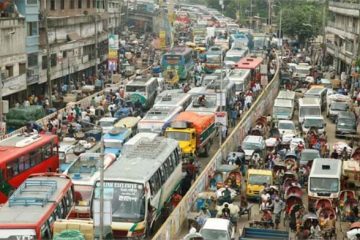 Air pollution in the capital has taken an alarming turn, posing serious health problems for city dwellers.
Air pollution in the capital has taken an alarming turn, posing serious health problems for city dwellers.
Things get worse in dry season as air, thick with particulates, becomes a prevalent cause of chest and respiratory diseases, say health experts, reports The Daily Star.
According to some sources of Department of Environment (DoE), the density of airborne particulate matter (PM) has reached 247 micrograms per cubic meter (mcm) in Dhaka which is nearly five times the acceptable level of 50 PM per mcm set by the National Ambient Air Quality Standard (NAAQS) of Bangladesh.
Although there is no definite study, doctors suggest exposure to such a volume of air pollution may cause premature deaths and also various diseases including pulmonary, respiratory and neurological illnesses.
This air pollutant also has an adverse effect on all other life forms including plants. Cost of maintaining building structures in the urban areas also rises significantly due to such air pollution.
Doctors at the National Institute of Diseases of Chest and Hospital (NIDCH) in Mohakhali said number of patients soars at the very onset of the dry season and continues till the monsoon rain arrives.
NIDCH Director and Professor Dr Mirza Mohammad Hiron told The Daily Star that the number of patients with different chest and respiratory diseases is on the rise.
“We have thousands of patients treated during dry season for diseases triggered by allergic reactions, which strongly suggests it is related to exposure to pollution,” Hiron said.
Airborne particulates are considered more harmful when they are 10 micrometers or smaller in diameter and in Dhaka the density of PM which is 2.5 micrometers or smaller has been found to be 9 times higher than the NAAQS recommendation.
Ambient air in the city becomes extremely polluted between October and March every year when rain is scarce and when thousands of brick kilns become operational, burning used automobile and rickshaw tyres, low grade coal and in many cases fuel-wood.
“Our study shows that during 120 days of the dry season the ambient air pollution remains very consistent in the city air,” said a researcher of the Air Quality Management Project that ended in 2008.
He said in addition to brick kilns, old buses, fleets of trucks and thousands of other poorly serviced vehicles contribute highly to the pollution. Moreover, dust from roads and construction sites and toxic fumes from industrial sites turn the air quality scenario even worse.
“The first thing we have to do is to ban these old buses and trucks from entering the city. The old buses engaged in city services must immediately be replaced by larger environment friendly buses,” said the former AQMP official requesting anonymity.
World Health Organisation (WHO) air quality guidelines of 2005 however recommend a maximum acceptable PM level of 20mcm compared to Bangladesh standard of 50. Cities with 70mcm are considered highly polluted. Airborne lead is the worst of the harmful PMs.
Meanwhile, government’s initiative to borrow $62.2 million from the World Bank for Clean Air and Sustainable Environment Project (CASE) brings some relief among environment activists.
The project, which was launched in October 2009 and lasts until December 2014, mainly aims at addressing various aspects of city’s transportation sector and also to modernise the brick kilns to reduce pollution.
DoE and Dhaka City Corporation will jointly implement the project.
A CASE official at the DoE office in Agargaon said under the project the 100 years old technology of brick burning would be replaced by modern methods.

















